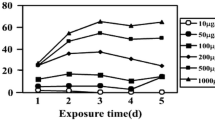Abstract
Biochemical and biophysical parameters, including D1-protein turnover, chlorophyll fluorescence, oxygen evolution activity and zeaxanthin formation were measured in the marine seagrassZostera capricorni (Aschers) in response to limiting (100 μmol·m−2·−1), saturating (350 μmol·m−2·s−1) or photoinhibitory (1100 μmol·m−2·s−1) irradiances. Synthesis of D1 was maximal at 350 μmol·m−2·s−1 which was also the irradiance at which the rate of photosynthetic O2 evolution was maximal. Degradation of D1 was saturated at 350 μmol·m−2·s−1. The rate of D1 synthesis at 1100 μmol·m−2·s−1 was very similar to that at 350 μmol·m−2·s−1 for the first 90 min but then declined. At limiting or saturating irradiance little change was observed in the ratio of variable to maximal fluorescence (Fv/Fm) measured after dark adaptation of the leaves, while significant photoinhibition occurred at 1100 μmol·m−2·s−1. The proportion of zeaxanthin in the total xanthophyll pool increased with increasing irradiance, indicative of the presence of a photoprotective xanthophyll cycle in this seagrass. These results are consistent with a high level of regulatory D1 turnover inZostera under non-photoinhibitory irradiance conditions, as has been found previously for terrestrial plants.
Similar content being viewed by others
References
Adams WW, III, Demmig-Adams B, Verhoeven AS, Barker DH (1995) ‘Photoinhibition’ during winter stress: involvement of sustained xanthophyll cycle-dependent energy dissipation. Aust J Plant Physiol 22: 261–276
Aro E-M, McCaffery S, Anderson JM (1993a) Photoinhibition and D1 protein degradation in peas acclimated to different growth irradiances. Plant Physiol 103: 835–843
Aro E-M, Virgin I, Andersson B (1993b) Photoinhibition of photosystem II. Inactivation, protein damage and turnover. Biochim Biophys Acta 1143: 113–134
Critchley C, Russell AW (1994) Photoinhibition of photosynthesis in vivo: the role of protein turnover in photosystem II. Physiol Plant 92: 188–196
Demmig-Adams B, Adams III, WW (1992) Photoprotection and other responses of plants to high light stress. Annu Rev Plant Physiol 43: 599–626
Dennison WC, Alberte RS (1982) Photosynthetic responses ofZostera marina L. (eelgrass) to in situ manipulations of light intensity. Oecologia 55: 137–144
Fotinou C, Kokkinidis M, Fritzsch G, Haase W, Michel H, Ghanotakis DF (1993) Characterization of a photosystem II core and its three-dimensional crystals. Photosynth Res 37: 41–48
Gilmore AM, Yamamoto HY (1991) Resolution of lutein and zeaxanthin using a non-endcapped lightly-loaded C18 high-performance liquid Chromatographic column. J Chromatogr 543: 137–145
Ohad I, Kyle DJ, Arntzen CJ (1984) Membrane protein damage and repair. Removal and replacement of inactivated 32 kilodalton polypeptides in chloroplast membranes. J Cell Biol 99: 481–485
Ohad I, Adir N, Koike H, Kyle DJ, Inoue Y (1990) Mechanism of Photoinhibition in vivo. A reversible light-induced conformational change of reaction center II is related to an irreversible modification of the D1 protein. J Biol Chem 265: 1972–1979
Porra RJ, Thompson WA, Kriedelman PE (1989) Determination of accurate extinction coefficient and simultaneous equations for assaying chlorophyllsa andb extracted with four different solvents: Verification of the concentration of chlorophyll standard by atomic absorption spectroscopy. Biochim Biophys Acta 975: 384–394
Russell AW, Critchley C, Robinson SA, Franklin LA, Seaton GGR, Chow WS, Anderson JM, Osmond CB (1995) Photosystem II regulation and dynamics of the chloroplast D1 protein ofArabidopsis leaves during photosynthesis and photoinhibition. Plant Physiol 107: 943–952
Schnettger B, Santore UJ, Critchley C, Leitsch J, Krause GH (1992) Light-induced turnover of the D1 protein of the photosystem II reaction centre and photoinhibition in vivo. In: Murata N (ed) Research in photosynthesis, vol. IV. Kluwer Academic Publishers, Dordrecht, pp 423–426
Sundby C, McCaffery S, Anderson JM (1993) Turnover of the photosystem II D1 protein in higher plants under photoinhibitory and nonphotoinhibitory irradiance. J Biol Chem 268: 25476–25482
Syme AS, Bolhàr-Nordenkampf HR, Critchley C (1992) Light-induced D1 protein degradation and photosynthesis in sun and shade leaves. In: Murata N (ed) Research in photosynthesis, vol. IV. Kluwer Academic Publishers, Dordrecht, pp 337–340
van Wijk KJ, van Hasselt PR (1993) Photoinhibition of photosystem II in vivo is preceded by down-regulation through light-induced acidification of the lumen: Consequences for the mechanism of photoinhibition in vivo. Planta 189: 359–368
Vogelmann TC (1993) Plant tissue optics. Annu Rev Plant Physiol Plant Mol Biol 44: 231–251
Author information
Authors and Affiliations
Corresponding author
Additional information
We would like to thank Professor Peter Böger (Department of Plant Biochemistry, University of Konstanz, Germany) for the kind gift of D1 antibodies. This work was partly supported by a University of Queensland Enabling Grant to CC.
Rights and permissions
About this article
Cite this article
Flanigan, Y.S., Critchley, C. Light response of D1 turnover and photosystem II efficiency in the seagrassZostera capricorni . Planta 198, 319–323 (1996). https://doi.org/10.1007/BF00620046
Received:
Accepted:
Issue Date:
DOI: https://doi.org/10.1007/BF00620046




